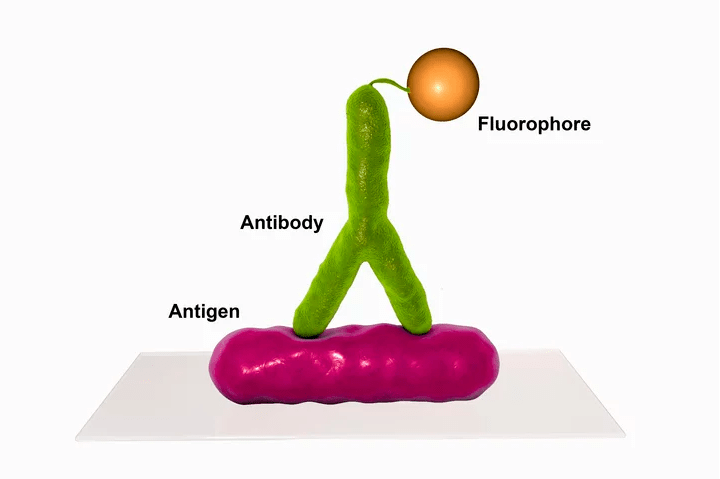The Enzyme Linked Immunosorbent Assay (ELISA) is a gold standard analytical method for the detection of various compounds, and is the most commonly used immunoassay technique for labs and research.
The assay is based on the lock-and-key specificity between an antibody-antigen pair. Antibodies are naturally made by the adaptive immune system to recognize a specific piece of an antigenic protein. This is what allows the body to identify and fight invading pathogens so effectively. Since antibodies have such a fundamental role in most biosensing and diagnostic systems it is very easy to purchase them or have them custom-made to recognize a protein of interest.
The ELISA assay is performed in 96- or 384-well plates that are treated to favorably adsorb antigen or antibody depending on the type of ELISA being performed. The ELISA assay is built up from the bottom of each well; it doesn’t float freely in the well. As a result, the unbound proteins are easily washed away and only the target remains to be quantified.
Types of ELISA techniques
Each technique of ELISA is used for a different purpose. Some are good at detecting antigen while others are used to detect antibodies. All of them require the use of a fluorescent, chemiluminescent, or colorimetric tag. These tags are called reporters and used to quantify the assay.
- Direct ELISA: The antigen is immobilized on the surface of the plate and is detected by an antibody conjugated to a reporter. A higher signal equals more target.
- Indirect ELISA: The antigen is immobilized on the surface of the plate and two antibodies are used for detection. The primary antibody binds to the antigen and the secondary antibody binds to the primary antibody. The secondary antibody is conjugated to a reporter, and it cannot recognize the antigen. Therefore, without any primary antibody the secondary will be washed away and there will be no signal to quantify. Therefore, the indirect ELISA is used to detect primary antibodies in a sample. A higher signal equals more target.
- Sandwich ELISA: An antibody is immobilized on the surface of the plate. The antigen is added and it binds to the antibody. Then, another antibody, which recognizes a different epitope of the antigen, is added to the well and it also binds to the antigen. Finally, a third antibody with a reporter is added to recognize the second antibody. This method is used to detect antigen in a sample. A higher signal equals more target.
- Competitive ELISA: A reference antigen is immobilized on the surface of the plate. The sample antigen is pre-incubated with a labeled reporter antibody and added to the wells. Any free antibodies unbound with antigen during the pre-incubation step will be able to bind to the reference antigen. All other labeled antibodies will be unable to bind to the immobilized antigen and will be washed away. This method is used to detect antigen in a sample. A higher signal equals less target.
Benefits and drawbacks of ELISA techniques
ELISA techniques have high sensitivity and throughput, are cheap, reproducible, easy to use, compatible with different samples, and require small volumes of samples of interest. Nevertheless, they are time-consuming as a detectable immune complex is required. The detected compound(s) with low solubility require(s) solvents for extraction which in turn denature antibodies affecting antigen-antibody bonding characteristics.
To overcome the drawbacks of ELISA different techniques were introduced such as charged carriers or polyelectrolytes, suspension of ultradispersed immunosorbents, and magnetic immunosorbents (such as magnetic beads) which are more promising among all.
Magnetic beads are composites (typically >500 nm) of a no-magnetic matrix (polystyrene, silica, PVA) charged with magnetic nanoparticles (usually magnetite about 10 nm).
Application of magnetic beads in competitive ELISA techniques
With the advance of nanotechnology, magnetic beads have been introduced and widely used as a solid phase in competitive ELISA immunoassay techniques for the isolation and purification of components such as proteins, peptides, hormones etc. Magnetic beads, due to their large surface area, biocompatibility and magnetic behavior, are promising as analytes of interest can be immobilized and released easily by applying an external magnetic field which in turn improves following analytical sensitivity and detection time.
In the direct approach the antibody is covalently immobilized on the surface of beads forming a magnetic bead-based technique to detect the analyte of interest, whereas, in the indirect approach and for some particular analytes, the analyte is bound to the surface of magnetic beads.
The application of magnetic beads in immunoassays has major benefits. Magnetic beads due to their small size are easily manipulated and are uniformly distributed in solution. The external magnetic field when applied can collect and transfer them from one solution to another. Hence, homogeneous reactions are conducted with efficient heterogeneous isolation and purification of different components simultaneously such as nucleic acids, hormones, proteins, viruses, and even whole cells.
Furthermore, the physical properties of magnetic beads render them detectable. This diminishes the background signal (assayed media rarely contain magnetically sensitive components), and decreases the limit of detection, and achieves high specificity.
Related news





